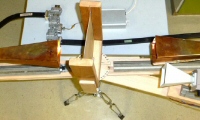Accept
Details & settings
This website uses cookies for cookie consent and statistics.
Adrian Lenkeit, Marvin Lohaus, Max Oehmichen

Optical data processing has many advantages over electronic data processing. It offers large bandwidth and faster data transmission. However, currently it is based on expensive nonlinear materials and requires high intensity lasers resulting in high cost and large energy requirements.
Our research enables us to use linear materials, which are cheap and energy efficient as they do not require high intensities. The superposition principle should prevent waves from influencing each other, however, standing waves and thin linear materials enable one wave to switch another. We tested our theoretical considerations by developing novel optical logic gates that switch microwave radiation. First we simulated these optical logic gates with self-written software based on Maxwell's equations and then we tested them experimentally.
Our project is based on a simple idea. An electromagnetic wave that is incident on a material will be affected by the material, e.g. its intensity could change. However, if a sufficiently thin material is illuminated by a second coherent electromagnetic wave in such a way that the material is located at a node of the resulting standing wave, then the material cannot influence the wave. We demonstrate that this allows the realization of optical logic gates.